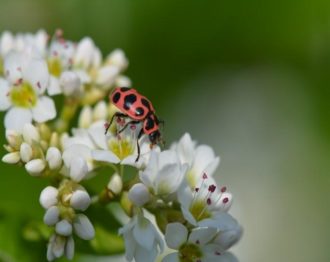Beneficial insects play an important role in managing insect pests and pollinating crops, but they struggle to thrive in and around farms that have low plant diversity and rely mainly on tillage. Routine soil disturbances and low plant diversity can mean fewer prey, shelter and plant-based resources available to support natural enemies, especially early in the season when their food is scarce. “I like to remind producers that good bugs are more than just predators—they rely on plants for food and shelter as well. Without sufficient plant diversity on the farm, they can't thrive and do their jobs,” said entomologist Jermaine Hinds.
While pursuing a doctorate at Penn State University, Hinds joined an ongoing research project with his advisor Mary Barbercheck and a team of researchers who wanted to compare the benefits of growing more diverse cover crop mixtures in a wheat-corn-soy rotation. “We were excited to see if we could take advantage of the unique traits of different cover crops, especially in mixtures, in order to help build soil, manage weeds and regulate pests,” said Hinds.
When farmers plant cover crops, they often have to terminate it before it can reach peak bloom, thus losing the opportunity to provide natural enemies and pollinators with early-season nectar and pollen. While the research team was at first challenged by the idea of delaying termination of the cover crop to allow for bloom time, Hinds began to think of ways they could reintroduce floral diversity into the landscape without compromising management of the crop.
“We decided that we could partially terminate the cover crop and leave behind a border made up of diverse flowering cover crops that would reach peak bloom and would support beneficial insects later into the season.”
With support from a 2014 SARE Graduate Student grant, Hinds was able to further his research into using flowering cover crops to support natural enemies. Wanting to take advantage of the unique benefits offered by different cover crop species, he decided to test buckwheat and cowpeas to see how effectively they could support natural enemies in a nearby corn crop.
Through his research, Hinds found that important natural enemies, like the pink-spotted lady beetle and insidious flower bug, were more common in fields with a neighboring flowering cover crop. Although the research team could not reliably establish cowpeas due to wet spring field conditions, their laboratory studies also yielded some interesting results.
In the lab, they found that insidious flower bugs, which are important predators in many cropping systems, survive longer and lay more eggs when given plant nectar and pollen from either buckwheat or cowpeas. “When we raised insects on both plant species together, they survived even longer and laid even more eggs,” Hinds noted. “This kind of research can help us think about the particular plants we can use to bolster important natural enemies and about how to design cropping systems and rotations where we can take advantage of the services provided by beneficial insects.” The team shared their research with enthusiastic growers at farmer field days and garnered a lot of interest in flowering mixtures and how they can support natural enemies in different cropping systems.
“Looking back, I think it was great that Mary encouraged all of her students to apply for SARE grants,” Hinds remarked. “The process definitely challenged us, and it was an excellent source of professional development. With my funded grant, I was able to expand my research, gain grant-writing and budget-management experience, as well as engage in networking and even collaborative research with the USDA.”
Recently, Hinds joined the team at SARE Outreach, where he uses his expertise to develop accessible and practical outreach materials for agricultural audiences and professionals. “I think it’s wonderful to have the opportunity to support a program that was so critical to my professional development and success in my graduate career.”

